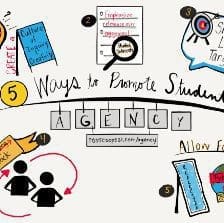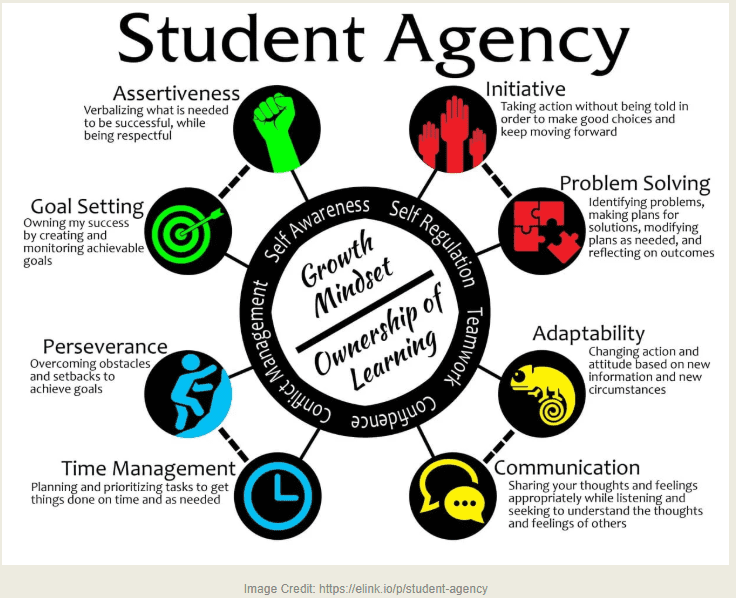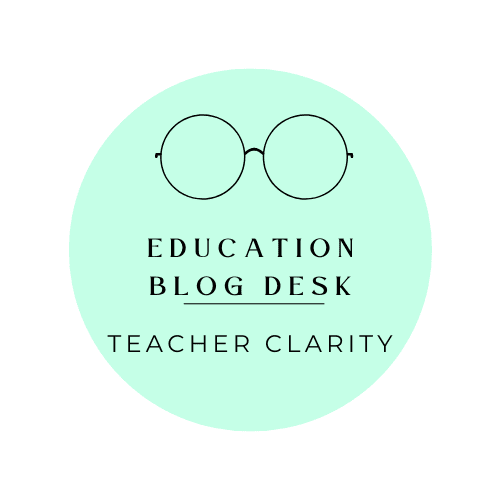
Build Framework for Student Agency
What is an Agency?
Bill Zima, author of Mindsets and Skillsets for Learning: A Framework for Building Student Agency, defines agency as the perceived ability of the individual, based on his or her capacity, to shape his or her life. You might wonder what does this look like in a classroom? Zima gives these scenarios:
- A kindergartner decides how a character should be represented in his story, even if it seems unconventional.
- A third grader creating and following a standard operating procedure, instead of always needing the teacher to tell her when and how to perform certain routines.
- The middle school student who works on the skill of organization, so he tracks his behavior with a chart and reporting his progress to himself and the teacher.
- A high school student takes a six-week learning opportunity that focuses on historical fiction of the American Revolution and analyzes how work represents the time frame.
Zima cites this quote from Stephanie M. Jones and Jennifer Kahn (2017), who coauthored the Aspen Institute’s report The Evidence Base for How We Are learning, stated:
“Students who have a sense of belonging and purpose, who can work well with classmates and peers to solve problems, who can plan and set goals, and who can persevere through challenges –in addition to being literate, numerate, and versed in scientific concepts and ideas — are more likely to maximize their opportunities and reach their full potential.” (p. 4)


Zima (2021) believes “these types of learning experiences will lead to adults who know how to set goals, plot pathways from their current selves to their desired future selves and feel secure in their mindsets and skill set to overcome obstacles.” (p. 8)
Why is Agency important?
Zima emphasizes that teachers cannot grant agency to students. They must develop within themselves. The question is how educators create the condition to make student agency a reality in schools? Zima points out that teachers need to connect information across disciplines to build knowledge and engage the whole learner. Zima cited Jones and Kahn (2017) their argument for the structure of learning:
“Decades of research in human development, cognitive and behavioral neuroscience, and education practice and policy, — have illuminated that major domains of human development — social, emotional, cognitive, linguistic, academic — are deeply intertwined in the brain and in behavior. All are central to learning.” (p. 4)
Zima argues educators cannot teach content separate from the process of information to build understanding. Zima believes students cannot learn social-emotional skills detached from thinking and need to actively think with others and pay attention to how they feel, how their actions make others feel. This reflection needs to take place while they are engaged in a problem with desirable difficulty.
Zima also argues that learning is a process that, if practiced, will get stronger, and the learner can practice effectively by critically analyzing the actions he or she has chosen, which prompts reflection. This lets the learner build better and stronger learning processes, and then use them to better predict future outcomes. Zima believes that reflecting on decisions and how those decisions helped learners reach their goals is a crucial part of what educators do.
Zima asks a crucial question: how do educators balance learning with the need to eventually arrive at the right answer? The answer: Students need to receive feedback on the process they used to reach the right answer. Zima describes his experience as a beginning teacher:
“I would return the unit test and mark learners’ incorrect responses. I would then move on to new learning. If the information was needed to future study, I was surprised when students still did not know it. I wrongly assumed students would go back and see why the answer they put was wrong, even though I certainly did not take this step as a student.” (pg. 9) You know what happens when students must review the incorrect answers — students need to reflect and use feedback to improve their schemas, to enhance their ability to think. No surprise there!
As Zima points out, learners should have opportunities to practice thinking. When learners are aware of their past success, the learners’ perceived ability to handle future challenges — their sense of agency — will increase.


Framework for Building Agency
The framework for building agency is a tool to provide educators to design learning opportunities that intentionally foster agency development. The framework consists of five parts:
- A classroom culture designed to encourage agency development
- An inquiry starter (an introductory activity designed to cause wonder
- Well defined learning targets
- An application of the knowledge
- Reflection before, during, and after the learning opportunity
Zima notes that how a teacher deliberately combines and executes the unit’s purpose will determine these parts. The framework provides guidance on how to account for actions that will lessen teachers’ need to control the pace of instruction during the unit. The teacher contemplates these possible moves before the beginning of the unit when using the framework.
Classroom Culture
Zima points out some characteristics of classroom culture:
- The teacher is the director, and not the compliance officer
- Students need opportunities to practice independence.
- Students need opportunities to figure out what to do next, without always having to clarify everything with the teacher.
- Students believe belonging is key to being in the right mindset to learn.
- Students create standard operating procedures (SOPs) for common routines like leaving the classroom, turning in work, or attending lunch count, which emphasizes independence rather than reliance on the teacher.
How Do I Plan Units that Build Agency?


Zima emphasizes that proper, deliberate planning is required for a unit that motivates learners to attend to a problem and discover a solution. Zima uses the agency unit planner to deliberately guide a teacher to start the four instructional parts of the framework for building agency (inquiry starter, learning targets, application of knowledge, and reflection). Example Agency Unit Planner. This way, a teacher can ensure a well-coordinated learning experience that will benefit students’ development of agency.
All the sections of the agency unit planner align with the four major parts —inquiry starter, learning targets, application of knowledge, and reflection. Specifically, the sections of the agency unit planner are as follows.
• Inquiry starter: Plan an activity that triggers wonder and link it to your initial ideas about the culminating project.
• Learning targets: Identify the learning targets and essential knowledge that form the foundation of the unit.
• Mindsets and skill-sets of agency: Select cognitive and meta-cognitive skills that will be an explicit part of the unit.
• Application of knowledge: List foundational knowledge, how students will learn it, how they will provide evidence they know it, and how to apply it to show they understand the concept or can execute the skill without error.
• Assessment plan: Plan specific assessments for foundational knowledge and the targeted understanding or skill.
• Culminating project: Design an authentic assignment that requires students to apply their learning.
• Reflection: Prepare for student reflection before, during, and after the learning experience.
The planner also includes a project calendar for drafting a schedule for when you will introduce new foundational knowledge and when you will assess. Note you will need to adjust to students’ needs throughout the unit. The project calendar is more of a guideline than a script. Blank Agency Planner
Conclusion
I hope this blog will help you understand what agency is and how to build a framework in the classroom. There are more blogs to come that will explain in more detail the agency unit components.
Reference
Zima, B. (2021). Mindsets and Skill Sets for Learning. Marzano Resources. https://bookshelf.vitalsource.com/books/9781943360369
